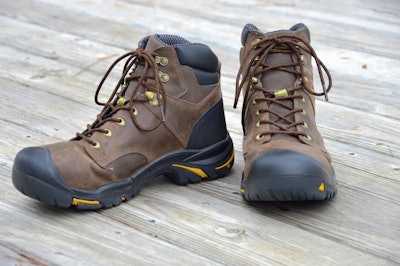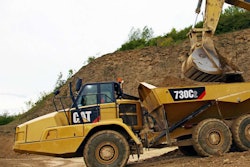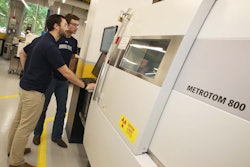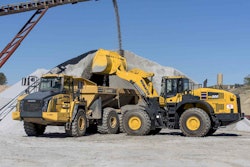 Keen’s Mt. Vernon Mids have running shoe comfort with hiking boot stability.
Keen’s Mt. Vernon Mids have running shoe comfort with hiking boot stability.For the last six months I’ve been putting a pair of Keen Mt. Vernon Mid boots through the paces. Long story short: Out of six pairs of boots in my closet, these are the ones I choose almost every time.
Made in the company’s Portland, Oregon factory, the Keen Mt. Vernon Mids (as in mid-length) have a composite thermoplastic shank and torsional plate in the sole which absorbs shock, puts a spring in your step and helps keep your feet balanced side to side. A removable dual-density EVA foot bed provides cushion and additional support. The polyurethane midsole resists compaction which means the boots retain that cushy feel over time.
Keen’s trademark asymmetric toe boxes give your toes plenty of wiggle room, yet the design of the boot cradles your foot firmly so it doesn’t move around inside the boot. Keen includes these boots in its “soft toe” lineup for light industrial applications where a steel or safety toe is not required. Nonetheless, the hard-shell toe and heel caps are rigid enough that I can kick concrete blocks and timbers into place and not feel any impact on my toes.
The lining of the boot is both waterproof and breathable. This helps keep the boots cooler and your feet drier as the day wears on, an important consideration in any hot or humid environment. And you don’t have to wear thick socks with these boots. In fact, they’re more comfortable with thinner socks. The tongue is well padded and doesn’t pinch up around the ankles when laced up tight—a problem I’ve had with a lot of boots.
 The boots’ beveled heel blocks create a comfortable, natural stride.
The boots’ beveled heel blocks create a comfortable, natural stride.Another aspect of the Mt. Vernon Mids that I like is what I call, for lack of a better term, their feedback. I wore them for most of a day recently while balancing on the edges of floor joists and wrestling with heavy sheets of of 5/8-inch OSB subflooring. When you are standing on nothing but joists, a boot with a traditional heel can feel wobbly, but the Keen’s have a livelier, tactile feel that enhances balance. I haven’t tried them walking top plate on a framing job but I’m confident they’d do well in that high-wire application as well.
The soles are non-marking and non-slip to ASTM F1617-96 standards. Practically speaking, this means the boots grip well enough that I don’t worry about my feet sliding out from under me on tile floors or concrete. If you’ve ever slipped on a hard surface that had sand, pea gravel, sawdust or concrete dust on it, you’ll appreciate the aggressive tread lugs on the Mt. Vernon’s which seem to stick very well in these conditions.
Online shoppers should note that the fit and feel of any boot can be tricky at first. I tried three different sizes of these boots before I found a pair that fit perfectly. On shoe gauges my feet measure 10-1/2, but for the Mt. Vernons, an 11 fit best.
In my first few outings the boots felt stiff, particularly in the heel. And early on, whenever I was kneeling with my toes bent up under me, the leather uppers pinched the top of my feet just behind the toes. But it didn’t take long for the boots to break in and these problems to disappear.
These are not boots you can resole. They cost about $200 online, which you may think is a lot for a boot you’re going to run to destruction. But look at it this way: construction is an athletic endeavor, and athletes pay close attention to the performance of their footgear. With the right boots, your feet will feel better, you’ll be less fatigued and perform better, and you are less likely to suffer an accident. These Keens offer all that and should last through at least two or three years of daily use. For $200, that’s a good deal.
The work I do is usually often vigorous. It includes carpentry, demolition, bending and twisting, climbing hills, pushing wheelbarrows, and hauling lumber, concrete and mulch. In those conditions, the Mt. Vernon Mids are the undisputed champs. They offer the best of three worlds, the all-day comfort and the feel of a good running shoe with the support of a hiking boot and the protection of a construction boot.












